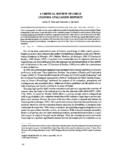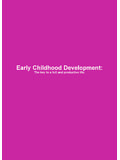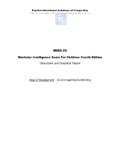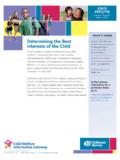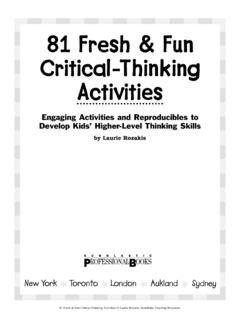Transcription of Early Moments Matter for every child - Home page …
1 Early Moments Matter for every child1 Early Moments Matter for every childEarly Moments Matter for every childi2 Foreword iiIntroduction: Building brains, building futures 1 Chapter 1: A baby s brain: The science 7 Case study: Visiting nurse programme 13 Visual: Nutrition, protection, stimulation 15 ViewpointThe H&M Foundation and UNICEF: A partnership for Early childhood development 17 Chapter 2: Nutrition 19 Case study: Nutrition and nurture in emergencies 23 Chapter 3: Protection 25 Case study.
2 The Better Parenting Programme 31 Chapter 4: Stimulation 33 Case study: Care for child Development 39 Case study: Pre-primary preparation for Grade 1 45 Chapter 5: Why invest in Early childhood development 47 Case study: Reaching Parents with an online portal to information 55 ViewpointThe Long-term Benefits of Quality Early Childcare for Disadvantaged Mothers and their Children 57 Chapter 6: Policies, programmes and partnerships 59 Case study: Policies, programmes and partnerships 65 Visual.
3 Programmes for children, family and futures 67 Viewpoint Chile Grows with Early Childhood Development 69 Chapter 7: Conclusion 71 Visual: Call to action 75 Endnotes 77 ContentsAcknowledgements Many individuals helped create this report. A debt of gratitude goes to: Omar Abdi, Deputy Executive Director; Justin Forsy th, Deputy Executive Director; Ted Chaiban, Director, Programme Division; Laurence Chandy, Director, Division of Research and Policy; Paloma Escudero, Director, Division of Communication; Lisa Benenson, Deputy Director, Division of Communication; Caroline den Dulk, Deputy Director, Division of Communication; Susana Sot toli, Deputy Director, Programme Division; Hai Kyung Jun, Representative, Chile; Megan Gilgan, Deputy Chief of Staff.
4 Dorothy Aanyu Angura, David Anthony, Maaike Arts, Sajeda Atari, Mariavit toria Ballot ta, Michael Banda, France Begin, Annika Br nning, Marissa Buckanoff, Jingqing Chai, Xuefeng Chen, Peck Gee Chua, Anna Danieli, Matias Delfino, Blanca Martinez Delgado, Ameena Mohamed Didi, Alison Earle, Maekelech Gidey, Deepa Grover, Caroline Guillot, Chika Hayashi, Jody Heymann, Maha Homsi, Priscilla Idele, Angus Ingham, Stephanie Jacquier, Jelena Zajeganovic Jakovljevic, Masahiro Kato, Deborah Toskovic Kavanagh, Jao Keis, Theresa Kilbane, Julia Krasevec, Diana Escobedo Lastiri, Jill Lawler, Elena Locatelli, Joan Lombardi, Anthony MacDonald, Fabio Manno, Alicia Marin, Kerida McDonald, Vrinda R.
5 Mehra, Najwa Mekki, Jadranka Milanovic, Christina Misunas, Daniela Mohaupt, Samantha Mort, Christine Nesbit t, Patricia N ez, Chloe O Gara, Margo O Sullivan, Clarice da Silva e Paula, Nicole Petrowski, Priyanka Pruthi, Chemba Raghavan, Amy Raub, Eduardo Garcia Rolland, Valentina Ruta, Anna Sandberg, Michael Sidwell, Pablo Stansbery, Morgan Strecker, Laura Andreea Seusan, Jordan Tamagni, Georgina Thompson, Daniel Timme, David Tsetse, Maria Elena Ubeda, Willeta Waisath, Samantha Wauchope, Aisha Yousafzai, J r me Pfaffmann ZambruniSpecial thanks: For guidance Early in the report draf ting process and for guiding the data, gratitude goes to Elinor Bajraktari, Ivelina Borisova, Claudia Cappa, Ana Nieto, Abbie Raikes, Haogen YaoReport team Author: Pia Rebello Brit to Writer and managing editor: Tara Dooley Fact checking: Yasmine Hage, Xinyi Ge, Baishalee Nayak Copy editing and proofreading: Timothy J.
6 DeWerff, Anita PalathingalDesign and illustration Big Yellow Taxi United Nations Children s Fund (UNICEF)September 2017 Permission is required to reproduce any part of this publication. Permissions will be freely granted to educational or non-profit organizations. Others will be requested to pay a small fee. Please contact: Division of Communication, UNICEF Attn: Permissions 3 United Nations Plaza, New York, NY 10017, USA Tel: +1 (212) 326-74 34 Email: ISBN: 978-92-806-4901-7A special thank youUNICEF extends a special thank you to the H&M Foundation for supporting this report and engaging in efforts around the globe to provide the best start in life for every Moments Matter for every childEarly Moments Matter for every childiiiiiForewordWhat s the most important thing children have?
7 It s their brains. And yet, we re not caring for children s brains the way we care for their bodies, especially in Early childhood, when what we do or fail to do has an impact on children s futures and the futures of their economies and their Moments Matter for every child , UNICEF s new global report on Early childhood development, shows that the period from conception to the start of school opens a critical and singular window of opportunity to shape the development of a child s rapid brain growth that happens during this period of life is astounding. At this time, brain connections form at an unrepeated speed, giving shape and depth to children s cognitive, emotional and social development influencing their capacity to learn, to solve problems and to relate to others.
8 This, in turn, has a significant impact on their adult lives, affecting their ability to earn a living and contribute to their societies .. even their future millions of the world s most disadvantaged children, we are missing this window of 20-year study showed that children from poor households who received high-quality stimulation at a young age earned an average of 25 per cent more as adults than those who did not receive these And yet, governments worldwide spend less than an estimated 2 per cent of their education budgets on Early childhood Moments Matter for every childEarly Moments Matter for every childvivChildren who do not receive the nutrition they need are at risk of stunted cognitive and physical development.
9 And yet, at least 155 million children suffer from stunting and millions more are at risk from poor , abuse, neglect and traumatic experiences produce high levels of cortisol a hormone that produces toxic stress that limits neural connectivity in developing yet, around the world, about 246 million children lived in conflict zones in 2015, 75 million were younger than 5. Millions more live in other Emerging research shows that breathing in particulate pollution can break down critical barriers in a child s developing brain, leading to the loss and damage of neural tissue. And yet, around the world, around 300 million children live in areas where the air is toxic, exceeding international limits by at least six happens to the children exposed to these dangers in their earliest days?
10 And what happens to their societies? When children miss out on the once-in-a-lifetime opportunity presented in Early childhood to develop healthy brains and lives, we as a global community perpetuate intergenerational cycles of disadvantage and by life, missed opportunity by missed opportunity, we are increasing the gap between the haves and the have-nots and undermining our own long-term strength and today s children are tomorrow s skilled workers. Doctors. Teachers. Lawyers. Leaders. Their productivity will fuel tomorrow s economies. Their capacity to contribute will shape tomorrow s we do now to foster their brain development and potential will determine their futures and our Lake UNICEF Executive Director FOREWORDE arly Moments Matter for every childEarly Moments Matter for every child21 The science is clear: A child s brain is built, not The process begins before birth and involves a complex interplay of neural connections that are shaped by experience and In the Early years, these neural connections occur at lightning speed a speed never again repeated.










